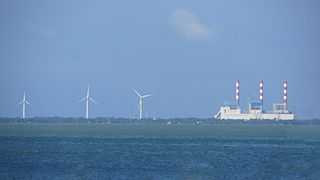Lakvijaya Power Station
| Lakvijaya Power Station | |
|---|---|
 | |
 | |
| Country | Sri Lanka |
| Location | Norocholai, Puttalam |
| Coordinates | 08°01′00″N 79°43′24″E / 8.01667°N 79.72333°ECoordinates: 08°01′00″N 79°43′24″E / 8.01667°N 79.72333°E |
| Status | Operational |
| Construction began | 11 May 2006 |
| Commission date | 22 March 2011 |
| Construction cost | US$1.35 billion (all 3 phases) |
| Operator(s) | CEB |
| Constructor(s) | CMEC |
| Power station | |
| Primary fuel | Low-sulphur coal |
| Generation units |
Phase 1: 1 × 300 MW Phase 2: 1 × 300 MW Phase 3: 1 × 300 MW |
| Combined cycle? | Yes |
| Power generation | |
| Installed capacity | 300 MW |
| Maximum capacity | 900 MW |
| Annual generation | Phase-1: 1,658 GWh |
| As of October 2012 | |
The Lakvijaya Power Station (also known as the Norocholai Power Station after its location) is a large coal-fired power station in Norocholai, Puttalam, Sri Lanka. Construction of the facility began on 11 May 2006, and concluded with the commissioning on 22 March 2011.[1] The first 300-megawatt phase was completed and ceremonially commissioned by President Mahinda Rajapaksa on 22 March 2011 at 18:27 local time, with the presence of Minister of Energy Champika Ranawaka, deputy Minister of Energy Premalal Jayasekara. The former Minister of Energy John Seneviratne could not attend the event as he was injured in a traffic accident on the way to the ceremony.[2][3]
According to the Ceylon Electricity Board, the US$455 million first phase generates nearly 1.7 TWh of electricity annually; a very significant amount when compared to Sri Lanka's total production of 11.5 TWh in 2011.[4] The plant is connected to the grid via 115 km (71 mi) 220-kilovolt transmission line to Veyangoda. Power station exhausts are emitted through a 150 m (492 ft) tall chimney, one of the country's tallest man-made structures.[1]
During its pre-development stages, a number of protests were launched by residents living at the project site, claiming that they were deceived by the government.[5]
Construction of the 600 MW Phase-1 and Phase-2 units were officially inaugurated by the President in March 2010.[6]
Incidents
- A large fire broke out on 24 October 2010. According to the Ceylon Electricity Board, there were no casualties. The Ministry of Power and Energy commented that damages to the facility would be borne by the constructors, and not the government or the developers.[7]
- On 22 July 2012, the power station ceased operations due to a leak in one of the thousands of tubes carrying water between the boiler. The country was put into controlled regional power outages to cope with the missing 300MW.[8]
- On 8 August 2012, a tripping of the powerline from Lakvijaya caused the power station to cease operations.[9]
- The generation capacity of the power station exceeded its designed levels of 300MW on 29 January 2013, causing a complete shutdown. The plant was reactivated a day later. [10][11]
Operation
In the plant, basically the electricity is produced using steam turbine which is capable of producing 300MW. Coal is used as the fuel in the purpose of producing steam that will then be used to rotate the turbine in the speed of 3000rpm. Coal is imported from Indonesia since it's cheap and good in quality. Even though the coal in India is very cheaper as compared with Indonesia, Indonesian coal is used since the coal in India contains more sulfur.
At first the coal is brought from Indonesia via ships (65tons per ship) and the ships are anchored around 4km far from the shore. This coal is brought in to the plant by using barges (long flat-bottomed boats) and then by conveyors.
The coal brought should be maintained around 10% moisture content immediately before it's used. The coal needs to be ground as powder before it's burnt. There are 5 "Mills" which are used to pulverize (grind) the coal. Basically, four ball mills work at a time while another one in standby.
See also
References
| Wikimedia Commons has media related to Lakvijaya Power Station. |
- ↑ 1.0 1.1 "Norocholai Coal Power Plant Project" (PDF) (in English). Ministry of Planning and Finance. Retrieved 23 March 2011.
- ↑ "Minister injured in accident". Daily News (in English). Retrieved 23 March 2011.
- ↑ "Minister's vehicle collides with bus". DailyMirror.lk (in English). Retrieved 23 March 2011.
- ↑ CEB Statistics, retrieved 2012-10-07
- ↑ "Displaced families complain of shocking deception". SundayTimes.lk. 13 April 2008. Retrieved 13 October 2012.
- ↑ "Coal-fired power plants around the world". IndustCards.com. 11 March 2012. Retrieved 13 October 2012.
- ↑ "Government won't bear costs of Norocholai fire". AdaDerana.lk. Retrieved 2 December 2010.
- ↑ "Cause of Lakvijaya breakdown identified". AdaDerana.lk. 24 July 2012. Retrieved 13 October 2012.
- ↑ "Power cuts again". DailyMirror.lk. 8 August 2012. Retrieved 13 October 2012.
- ↑ "Norochcholai Coal Power Plant at a standstill". DailyMirror.lk. 29 January 2013. Retrieved 3 February 2013.
- ↑ "Norochcholai back to life". DailyMirror.lk. 30 January 2013. Retrieved 3 February 2013.